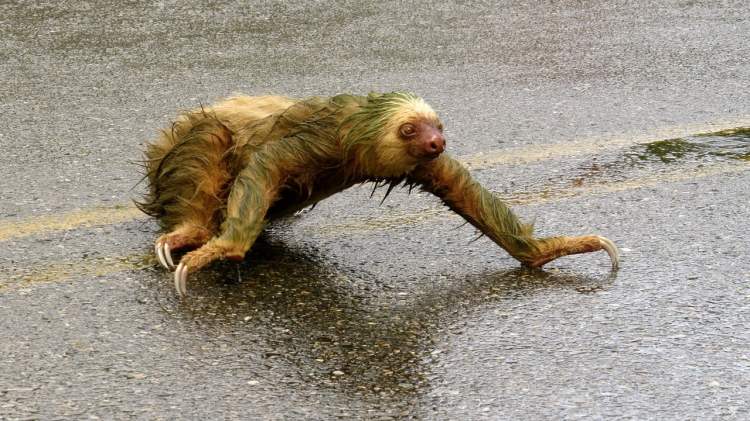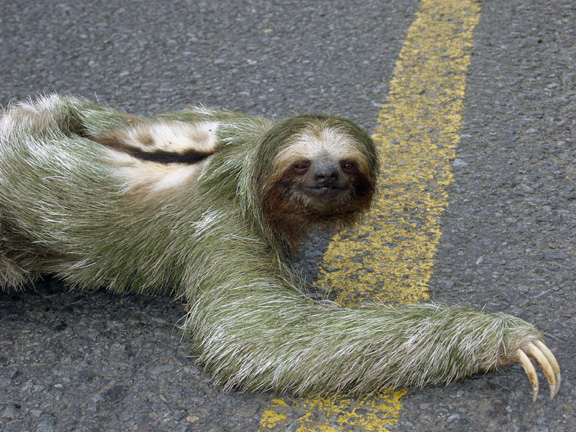
Three-toed sloth festively sporting green fur. In case the common names get confusing, remember that all sloths have three toes. The distinguishing number of digits is in the hand. Image credit: Azulia via Pixabay.
Sloths are pretty darned slow. So slow that they seem overtaken by the ever-creeping growth of the rainforest.
There are six living species of sloth distributed across Central and South America and each of these species have individuals observed with striking green fur. This green comes from algae, primarily Trichophilus welckeri (Suutari et al. 2010). But it is not just green algae that inhabit sloth fur. The hairy pelage is a practical ecosystem supporting a community of microbes, fungi, roundworms, beetles, cockroaches, and moths (Suutari et al. 2010).
You might want to think about that the next time you are taken with the impulse to pluck a sloth out of a tree and hug it.
Modern research has shed some interesting light upon the relationship between sloths and the green algae in their fur. Suutari et al. (2010) undertook an analysis of hair samples taken from all six living sloth species. Of the 71 total samples, 73% hosted green algae, with Trichophilus being the most frequently found and abundant. But genetic signatures from rRNA retrieved from the hairs showed a diverse assemblage of eukaryotes most likely acquired from the environment.

Microstructure of three-toed sloth, Bradypus hair. Note the irregular cracks. Image taken with scanning electron microscopy (SEM). Image credit: Wujek & Cocuzza (1986).

SEM of two-toed sloth, Choloepus hair. The microstructure of this hair shows longitudinal grooves. In both the three- and two-toed sloth, these grooves and cracks are home to green algae, cyanobacteria, diatoms, and other microbes (Suutari et al. 2010). Image credit: Wujek & Cocuzza (1986).
The appearance of green algae was most commonly found in the three-toed sloths (within the genus Bradypus). But what was even more interesting is that the various strains of Trichophilus algae found on all the different species of Bradypus throughout Central and South America are all closely related to each other. In fact, the Trichophilus algae found on a given species of Bradypus would be more genetically related to the algae on a geographically distant Bradypus species than with the Trichophilus algae found in the fur of a local two-toed sloth (Choloepus spp.). This suggests a long history of co-evolution between Bradypus and Trichophilus, one that might be an echo of the divergence between three- and two-toed sloths approximately 20 million years ago (Suutari et al. 2010).

Green-furred two-toed sloth (Choloepus spp.) crossing a road in Costa Rica. Image credit: Chirriposa Retreats via Vimeo.
It had long been assumed that the presence of green algae was part of a symbiotic relationship where the sloth provided shelter for algal growth and the algae in turn provided some kind of camouflage for sloths as they whiled away in the verdant canopy, protecting them against aerial predators (Pauli et al. 2014). There are other hypotheses out there as well. And some of these are a bit “out there.” It has been proposed that algae provide a nutritional boost for sloths, who are burdened with a low-energy leaf diet. Someone has suggested that sloths receive nutrients that diffuse into the hairs and absorb into the skin (Suutari et al. 2010). But that seems a bit silly.
Pauli et al. (2014) proposed a more complex symbiotic relationship based on the observation that three-toed sloths (Bradypus spp.) make regular descents down from the trees to poop on the ground. Why bother with this dangerous and exhausting journey to do your business? Clambering down a tree once a week is estimated to use up about 8% of a sloth’s daily energetic budget, in addition to the statistics that more than half of adult sloth mortalities occur as a result of predation events on or near the ground. The authors of this study put forth that these weekly visits to established latrine sites “sustains an ecosystem in the fur of sloths, which confers cryptic nutritional benefits.”
Are you ready for this?
Remember the moths that also live in sloth fur? They lay their eggs in sloth poop. Revisiting these latrine sites provides an opportunity for female moths to lay eggs and for the next generation of moths to colonize the sloth’s fur. An increase in the moth population also increases the amount of nitrogen, which feeds the growth of algae. Finally, the sloth consumes this “algae-garden”, which is supposedly highly digestible and rich in fats, as a nutritional supplement to their otherwise poor diet (Pauli et al 2014).

Image credit: Pauli et al. (2014).
While this is certainly a novel idea that could benefit from further investigation, the researchers have yet to provide conclusive evidence for this symbiosis. While algal cells were found in the stomach of sloths, it is difficult to say if there is enough being consumed to provide significant nutritional benefits. Likewise, this hypothesis could be supported by behavioral studies showing licking of the fur that would remove algae for consumption. Also, it does not address the observation that the presence of green algae is common, but not universal, amongst three-toed sloths.
Green sloths remain a mystery. But in the world of mammals, green is a very rare color to be found in the hair or skin. So let’s raise our glasses to the sloths, who are so lucky to have this unusual color!

This Bradypus is keepin’ it green, keepin’ it real. Image credit: Justin Lindsay via Flickr.
References
Fountain, Emily D. et al. 2017. “Cophylogenetics and biogeography reveal a coevolved relationship between sloths and their symbiont algae.” Molecular Phylogenetics and Evolution 110: 73 – 80.
Pauli, Jonathan N. et al. 2014. “A syndrome of mutualism reinforces the lifestyle of a sloth.” Proceedings of the Royal Society B 281 (1778): 20133006.
Suutari, Milla et al. 2010. “Molecular evidence for a diverse green algal community growing in the hair of sloths and a specific association with Trichophilus welckeri (Chlorophyta, Ulvophyceae).” BMC Evolutionary Biology 10 (1): 86.
Wujek, Daniel E. & Joan M. Cocuzza. 1986. “Morphology of hair of two- and three-toed sloths (Edentata: Bradypodidae).” Revista de Biologia Tropical 34 (2): 243 – 246.